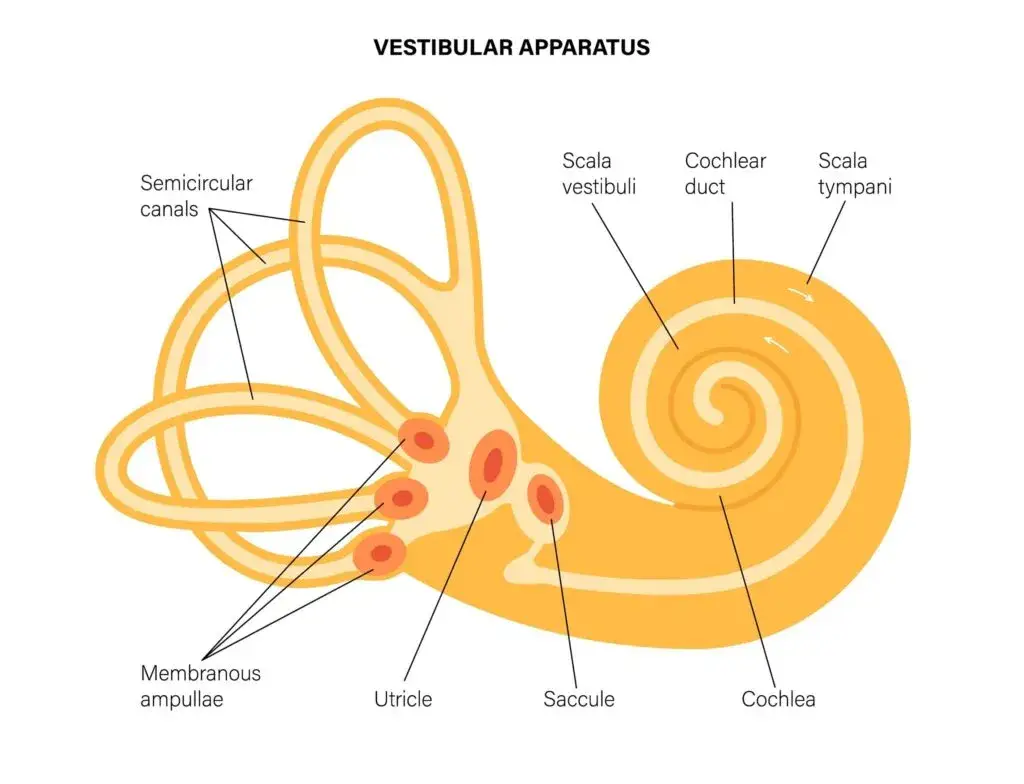
What Vertigo Means: Feeling like the room is spinning or that you’re tilting when you’re perfectly still can be scary, disorienting, and exhausting. If you’ve wondered, “What does vertigo really mean—and why is it happening to me?” you’re in the right place. In this in-depth guide, we’ll break down what vertigo is (and isn’t), the most common symptoms, the leading types and triggers, and how gentle, precise upper cervical chiropractic care at Lavender Family Chiropractic in Sarasota, Florida helps people get to the root cause—so they can get their balance and their lives back.
What Vertigo Means: What Does “Vertigo” Actually Mean?
Vertigo is the sensation of motion when no real motion is occurring. Most people describe it as spinning, whirling, rocking, tilting, or feeling “pulled” to one side. Unlike simple lightheadedness, vertigo involves a mismatch between what your inner ears, eyes, and body are telling your brain about where you are in space. When those signals don’t line up, your brain interprets the mismatch as movement—hence the spin.
A few key points help clarify the term:
- Vertigo is a symptom, not a diagnosis. It describes how you feel; it doesn’t explain why.
- Vertigo is usually related to your vestibular system—the inner ear balance organs, their nerve connections, and how those signals integrate with your brain and neck.
- Vertigo can be brief and positional (triggered by certain head movements) or persistent and fluctuating, depending on the underlying cause.
Vertigo vs. Dizziness vs. Imbalance
The words people use for balance problems often overlap, but they point to slightly different experiences:
- Vertigo: A false sense of spinning/tilting/rocking.
- Dizziness: A vague unsteadiness or woozy feeling without clear spinning.
- Imbalance: Trouble standing or walking upright, like you’re veering or swaying.
Understanding which feeling dominates can guide the evaluation and help identify which system—inner ear, visual, neck/cervical, brain integration, or blood pressure regulation—needs attention.
Common Vertigo Symptoms
Because vertigo involves your whole “balance network,” it can come with varied, sometimes surprising symptoms:
- Spinning, tilting, rocking, or “on a boat” sensations
- Nausea or vomiting, motion sensitivity, carsickness
- Headaches or migraines (especially vestibular migraine)
- Ear fullness/pressure or ringing (tinnitus)
- Fluctuating hearing or sound sensitivity
- Visual blurring, light sensitivity, difficulty with busy patterns
- Brain fog, fatigue, difficulty concentrating
- Anxiety or a “wobbly” feeling in crowds or stores
- Neck stiffness, neck pain, or history of whiplash
- Feeling better when you stay still and worse when you turn, bend, or look up
No single symptom proves a diagnosis—but the pattern matters, as do your triggers (like rolling in bed, quick head turns, scrolling on your phone, or changes in weather/barometric pressure).
Why Vertigo Happens: A Quick Tour of Your Balance System
Your balance relies on three subsystems constantly talking to each other:
- Inner Ears (Vestibular System): Tiny sensors (semicircular canals and otolith organs) detect head motion and gravity.
- Eyes (Visual System): Track motion and keep your gaze stable when you move.
- Neck/Body (Proprioceptive System): Nerve receptors in muscles and joints—especially in the upper cervical spine—tell your brain where your head and body are relative to each other.
Your brainstem and cerebellum integrate these signals. If any one system is off—or if the integration center is overloaded—your brain experiences a mismatch, and vertigo can result. That’s why some people notice dizziness after neck strain, whiplash, prolonged desk posture, or even dental work that holds the jaw/neck awkwardly: the neck’s orientation signals can fall out of sync with the inner ears and eyes.
The Most Common Types of Vertigo
Vertigo has many potential causes. Here are the most common—and what sets them apart.
Benign Paroxysmal Positional Vertigo (BPPV)
- What it is: Small calcium crystals (“otoconia”) become displaced into one of the inner ear canals, confusing the balance sensors.
- How it feels: Sudden, brief spins (seconds to a minute) triggered by rolling in bed, looking up, bending over, or quick head turns. Often worse in the morning or when lying on the “problem” side.
- Clues: Positional triggers, short bursts, may come in clusters.
Vestibular Migraine (VM)
- What it is: A migraine variant where the balance network is hypersensitive. Vertigo may occur with or without head pain.
- How it feels: Minutes to hours (sometimes days) of spinning, rocking, visual motion sensitivity, light/noise sensitivity, brain fog, and nausea. Often a history of migraines or strong light/smell triggers.
- Clues: Sensory sensitivities, family/personal migraine history, stress or hormonal triggers.
Menière’s Disease
- What it is: Fluctuating inner ear fluid pressure affecting hearing and balance. Meniere’s Disease is debilitating.
- How it feels: Episodes lasting 20 minutes to several hours with rotational vertigo, ear fullness, tinnitus, and fluctuating hearing loss.
- Clues: Ear symptoms that change with attacks; may follow salt/water retention triggers.
Vestibular Neuritis/Labyrinthitis
- What it is: Inflammation affecting the vestibular nerve (neuritis) or both balance and hearing structures (labyrinthitis).
- How it feels: Sudden, intense vertigo lasting days with severe nausea; often follows a viral illness. Labyrinthitis typically adds hearing changes.
- Clues: Acute, prolonged vertigo with difficulty standing/walking, recent infection history.
Persistent Postural-Perceptual Dizziness (PPPD)
- What it is: Functional dizziness that persists after an initial trigger (like BPPV or vestibular neuritis).
- How it feels: Persistent rocking/swaying, worse with upright posture, complex visual environments (grocery aisles, scrolling screens).
- Clues: Non-spinning dizziness most days for ≥3 months, heightened by motion/visual complexity.
Mal de Débarquement Syndrome (MdDS)
- What it is: A lingering “on a boat” sensation after cruises/flights/car travel—or spontaneously.
- How it feels: Rocking/bobbing/tilting, often better while in motion and worse when still.
- Clues: Starts after passive motion exposure; improves during movement.
Cervicogenic Dizziness (Neck-Related Dizziness)
- What it is: Mismatch between neck proprioception and the inner ear/eye signals, often from upper cervical dysfunction (atlas/axis misalignment, muscle guarding, prior trauma).
- How it feels: Unsteadiness, drifting, or brief spins associated with neck pain/stiffness; aggravated by certain head/neck positions or sustained posture.
- Clues: History of whiplash, chronic neck tension, symptoms that track with neck mobility or posture.
Other Considerations
- Orthostatic intolerance (e.g., POTS), medication side effects, anxiety disorders, neurological conditions, and visual/eye teaming issues can all contribute. Often, more than one factor is at play—especially when neck dysfunction compounds a primary vestibular issue.
How the Upper Neck Influences Vertigo
Your upper cervical spine (the atlas C1 and axis C2) sits at the crossroads of balance control:
- Proprioception: Dense nerve receptors in the upper neck constantly inform your brain about head position. If those signals skew from misalignment, muscle guarding, or joint irritation, the brain’s “map” of where you are in space loses accuracy.
- Brainstem/Vestibular Integration: The atlas surrounds the lower brainstem where vestibular and eye movement centers integrate signals. Irritation or altered input can amplify motion sensitivity and nausea.
- Cervico-Ocular Reflex (COR): Your neck works with your eyes to keep vision stable. When neck input is off, vision can blur during motion, increasing dizziness.
- Autonomic Tone: Upper cervical dysfunction can shift the “fight/flight vs. rest/digest” balance, affecting blood flow regulation, sensitivity to motion, and even Eustachian tube behavior (people often report ear fullness/pressure that tracks with neck tension or weather changes).
This is why people with vestibular issues frequently notice their symptoms worsen with poor posture, device use (head forward, chin down), lifting, or after a minor car accident—even when the inner ear tests look “normal.” Correcting subtle misalignments and calming irritated tissues in the upper cervical region can restore more accurate signaling and reduce vertigo.
Upper Cervical Chiropractic Care at Lavender Family Chiropractic (Sarasota, Florida)
If you’ve searched “upper cervical chiropractor near me” or “vertigo doctor near me” and you’re in the Sarasota–Manatee area, you’ve likely found Lavender Family Chiropractic. Our clinic focuses on upper cervical chiropractic—a gentle, precise approach that helps restore balance to your nervous system and posture without the twisting, cracking, or popping many people worry about.
Here’s what sets our care apart:
- 3D CBCT Imaging: We use state-of-the-art 3D Cone-Beam CT to visualize the unique anatomy of your upper neck. This reveals micro-misalignments that standard images can miss and guides us to an individualized correction plan.
- Functional Nervous System Scans (Tytron): Our paraspinal infrared thermography measures autonomic nervous system patterns along your spine. It helps us understand how your body is adapting and when it’s ready for a precise adjustment.
- Gentle, Precise Adjustments: Using advanced upper cervical methods (including a refined knee-chest protocol), we deliver corrections measured in millimeters and degrees, tailored to your CBCT findings. No forceful twisting—just focused alignment to restore normal signaling.
- Stability-First Care: We prioritize how well your spine holds an adjustment. When the alignment is stable, your nervous system calms, your body integrates more accurate signals, and vertigo often diminishes in frequency and intensity.
Our three-doctor team—Dr. Rusty Lavender, Dr. Jacob Temple, and Dr. Will Guzinski—has helped many people across Sarasota, Bradenton, Lakewood Ranch, and beyond regain stability with a plan built around their unique structure, history, and goals.
What to Expect at Lavender Family Chiropractic
- Step 1: Discovery & History
We listen closely: the exact way you describe your vertigo, when it started, what makes it worse or better, and any neck injuries, dental work, sinus or ear issues, or concussion history. Patterns in your story matter. - Step 2: Targeted Testing
We perform upper cervical and neurological exams, balance/eye movement screens, and Tytron scans. If your case is a good fit, we proceed to 3D CBCT to map your atlas/axis alignment in detail. - Step 3: Precision Analysis
Using your CBCT angles and measurements, we determine the exact vector for a gentle, specific upper cervical correction—nothing generic or cookie-cutter. - Step 4: First Correction
A focused adjustment is delivered—no twisting or popping. Many patients feel lighter or more level right away; others notice gradual changes over the first few visits as swelling calms and muscle memory resets. - Step 5: Re-Testing & Care Plan
We re-check your nervous system scan and motion tests, set a plan for stabilization, and teach you how to hold your alignment. The goal is lasting change, not quick fixes that fade.
Who We Help
We routinely see people with BPPV, vestibular migraine, cervicogenic dizziness, lingering post-concussion symptoms, barometric pressure sensitivity, ear fullness/“pressure,” and balance problems aggravated by neck motion or posture. Our approach is especially helpful for those who feel like they’ve “tried everything,” or whose tests keep coming back “normal” while their symptoms continue.
If you’re searching chiropractor Sarasota Florida, chiropractor near me, upper cervical chiropractic, Vertigo doctor near me, or Migraine doctor near me, we serve Sarasota, Bradenton, Lakewood Ranch, Parrish, Ellenton, Venice, Osprey, Punta Gorda, St. Petersburg, Siesta Key, Longboat Key, Lido Key, and Myakka City.
Real-World Results
- The “Bed-Spin” Sleeper: A 42-year-old who woke with spins every time she rolled to the right. ENT confirmed BPPV and canalith repositioning maneuvers helped—but episodes kept returning. Her CBCT revealed a subtle atlas tilt with asymmetric joint loading. After precise upper cervical corrections and posture retraining, her positional triggers faded and—most importantly—stayed away.
- The “Busy-Store” Floater: A 36-year-old with months of rocking, worse in grocery aisles and on the computer. Neurology labeled PPPD. With targeted upper cervical care and graded visual-vestibular re-exposure, his daily rocking decreased until he could shop and work confidently again.
- The Weather-Sensitive Parent: A 47-year-old whose ear fullness and head pressure spiked before storms. CBCT-guided adjustments plus stability coaching (sleep position, desk ergonomics) led to fewer flares and better tolerance to barometric changes.
Everyone’s story is unique, but the theme is the same: restore alignment, normalize signaling, and let the body stabilize.
Self-Care Tips You Can Start Today
- Neck-Friendly Posture: Keep screens at eye level, chin slightly tucked, shoulders relaxed.
- Move Gently, Often: Micro-breaks for neck range of motion and breathing every 30–45 minutes.
- Hydration & Minerals: Adequate water and balanced electrolytes support inner ear function and circulation.
- Sleep Smart: Use a supportive pillow (neutral neck), avoid sleeping face-down.
- Calm Inputs: If scrolling or busy visuals provoke symptoms, pace exposure and use larger text/solid backgrounds.
- Follow Medical Advice: If your provider recommends positional maneuvers for BPPV or medications during acute phases, coordinate those with structural care.
(If you experience red-flag symptoms—see below—seek urgent medical care.)
When to Seek Immediate Medical Care
Vertigo can rarely signal a serious issue. Go to urgent care or the ER if you have any of the following:
- Sudden, severe headache unlike anything before
- Double vision, slurred speech, facial droop, limb weakness, difficulty walking
- Chest pain, shortness of breath, fainting
- New hearing loss in one ear with severe vertigo
- Head injury or suspected stroke/TIA symptoms
Top 15 FAQs About Vertigo and Upper Cervical Care
1) Is vertigo the same as dizziness?
Not exactly. Vertigo implies a false sense of motion (spinning/tilting/rocking), while dizziness may feel more like lightheadedness or wooziness. Many people have a blend, but clarifying the sensation helps guide care.
2) Can the neck really cause vertigo?
Yes. The upper cervical spine is loaded with proprioceptors that feed your brain critical orientation data. If those signals are skewed by misalignment or irritation, your brain can perceive motion mismatches—leading to dizziness or vertigo.
3) I’ve tried BPPV maneuvers and my vertigo keeps coming back. Why?
If crystals are part of the problem but alignment and posture are still off, the system can stay irritable. Addressing upper cervical mechanics improves the stability of your balance network so episodes are less likely to recur.
4) What makes Lavender Family Chiropractic different for vertigo?
We combine 3D CBCT imaging with Tytron nervous system scans to design precise, gentle upper cervical corrections measured to your anatomy. No twisting or popping—just targeted alignment and a plan to help you hold it.
5) Do you treat vestibular migraine?
We don’t “treat migraine” like a medication would. We address structural and neurological contributors—upper cervical misalignment, posture, and autonomic imbalance—that often amplify vestibular migraine. Many patients report fewer and less intense episodes as their neck and nervous system stabilize.
6) Will I need adjustments forever?
Our goal is for you to hold your alignment as long as possible. Early on, visits may be more frequent. As stability improves, check-ins space out. Long-term, most patients prefer periodic wellness checks to stay ahead of stress and posture loads.
7) Can upper cervical care help ear fullness or pressure?
It can. By calming muscular tension and optimizing autonomic tone, some people notice better Eustachian tube function and less “pressure.” Results vary, but it’s a common improvement we hear.
8) Is the adjustment safe and does it hurt?
Upper cervical corrections are gentle and precise, with minimal force and no twisting or cracking. Most people find them comfortable—some feel immediate lightness or clarity.
9) How long before I feel better?
Some notice changes within a few visits; others improve steadily over weeks as inflammation and old muscle patterns unwind. Chronic or complex cases may take longer. Our re-testing helps track progress objectively.
10) Can I do vestibular rehab while under care?
Absolutely. Upper cervical care and vestibular rehabilitation often complement each other—alignment improves signal accuracy, while rehab retrains your brain to trust those signals again.
11) I’ve had vertigo for years—am I a lost cause?
No. Chronic cases can be discouraging, but with a careful history, targeted imaging, and a stabilization plan, many people finally make progress—even after years of searching.
12) Do you take insurance?
Our office is out of network with insurance. Many of our patients receive a superbill to submit to their insurance for reimbursement based on their coverage. We offer many different payment options as well as finance options.
13) What if my MRI/CT was “normal”?
Standard imaging often looks at the brain, not the exact alignment of the atlas/axis. Our 3D CBCT evaluates the micro-angles that can disrupt signaling without showing up on routine scans.
14) Can upper cervical care help if my vertigo started after a car accident or concussion?
Yes. Whiplash and concussion frequently affect the upper neck. Restoring alignment can reduce the sensory mismatch driving dizziness—and it’s a core reason many post-concussion patients seek us out.
15) How do I know if you’re the right fit?
If your vertigo changes with neck position, posture, stress, or barometric pressure—or if you’ve plateaued with other treatments—an upper cervical evaluation is worth exploring. We offer complimentary consultations so you can ask questions and feel confident in your plan.
Why Choose Lavender Family Chiropractic in Sarasota & Manatee
- Local leaders in upper cervical chiropractic: We focus on atlas/axis alignment all day, every day.
- Advanced diagnostics: 3D CBCT and Tytron scans reveal the “why” behind your symptoms.
- Gentle, precise methods: No twisting or cracking—your body deserves finesse, not force.
- Whole-person approach: Alignment, stability, posture coaching, and sensible lifestyle strategies.
- Trusted by the community: Families, professionals, athletes, and retirees throughout Sarasota, Bradenton, Lakewood Ranch, Parrish, Ellenton, Venice, Osprey, Punta Gorda, St. Petersburg, Siesta Key, Longboat Key, Lido Key, and Myakka City choose our team for vertigo, dizziness, headaches, TMJ, POTS, and more.
- Convenient location: 5899 Whitfield Ave Ste 107, Sarasota, FL 34243—easy access for Sarasota and Manatee counties.
If you’ve been searching chiropractor Sarasota Florida, upper cervical chiropractor near me, Vertigo doctor near me, or Migraine doctor near me, we’d be honored to help you write a new chapter.
Ready to Take Your Life Back?
You don’t have to plan your day around fear of the next spin. With the right plan—and the right precision—your balance system can calm, your confidence can return, and your world can stop moving when you’re standing still.
Lavender Family Chiropractic offers complimentary consultations to see if upper cervical chiropractic is a good fit for your vertigo, dizziness, or balance challenges. Call (941) 243-3729 or visit www.chiropractorsarasotaflorida.com to schedule.
Lavender Family Chiropractic in Sarasota Florida offers complimentary consultations to learn more about you. Click the link below!
https://intake.chirohd.com/new-patient-scheduling/724/lavender-family-chiropractic
Visit our Website!
To learn more about us go to http://www.chiropractorsarasotaflorida.com
We also service Bradenton, Parrish, Ellenton, Ruskin, Venice, Tampa, St. Pete, Osprey, Longboat, Lakewood Ranch, Myakka City.
If you are in Tampa, Fort Myers, or Salt Lake City, you can visit my other locations! NeckWise Upper Cervical. Visit, www.neckwise.com
If you are not local, visit www.uccnearme.com to find a doctor in your area.





